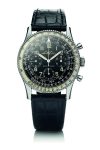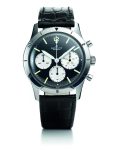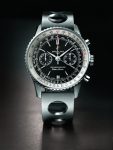Breitling
Collecting Navitimers
Breitling
Collecting Navitimers
But at the very moment it seemed that the last rites should be pronounced over this horological corpse, the seeds of its current renaissance were sown. Breitling was taken over by the Schneider family and gradually, during the 1980s, began to reassert itself. It was a remarkable comeback.
Today, Breitling is one of the best-known watch marques in the world. Three decades of prudent family management have built a business focused on communicating a simple message: big sturdy watches, usually chronographs, many with an aviation inclination, all of which are COSC-certified. And, as is often the case with a firm that is strong in current production, there has been an upturn in the prices achieved at auction.
You don’t have to take my word for it; Aurel Bacs, the legendary watch boss of Christie’s Geneva, backs me up. “The Navitimer is like the Omega Speedmaster and Rolex Submariner, forever taking a position in the hall of fame of tool watches,” explains the sage of the Place de la Taconnerie.
“The Navitimer is a watch that has gone up in value in the last decade like many other tool watches, being a counterpoint to the dressier ‘gentleman’ pieces made by famous Geneva manufacturers with double-barrelled names,” he says, alluding to the likes of Patek Philippe and Vacheron Constantin. Its popularity is also helped by Bacs’ observation that “the Navitimer is one of the coolest watches to wear every day”.
By the early 1960s, the company’s advertising told the world that “Breitling figures on the instrument panels of the 15 leading aircraft manufacturers or airlines”, adding that the Breitling Navitimer was “Specially recommended to airmen by the Aircraft Owners and Pilots Association AOPA”. The AOPA logo can be seen on many period pieces.
And, of course, as with any really iconic product of the 1960s, it received the ultimate sanction when it starred in the coolest Bond film of the age: Thunderball. A Breitling is both the timepiece of choice of the villainous military pilot who steals the bomb, and of agent 007 himself, who wears a Geiger-counter-equipped Breitling Top Time.
Happily, for those of us who love vintage Breitlings, prices are nowhere near that steep. For instance, Aurel Bacs reckons 10,000 Swiss francs will secure a tip-top Navitimer, which is probably one of the reasons it remains so wearable: prices have risen, but unlike the aviators who made Breitling famous, they have not soared out of reach.
Excerpted from an article by Nick Foulkes in REVOLUTION’s archives.














